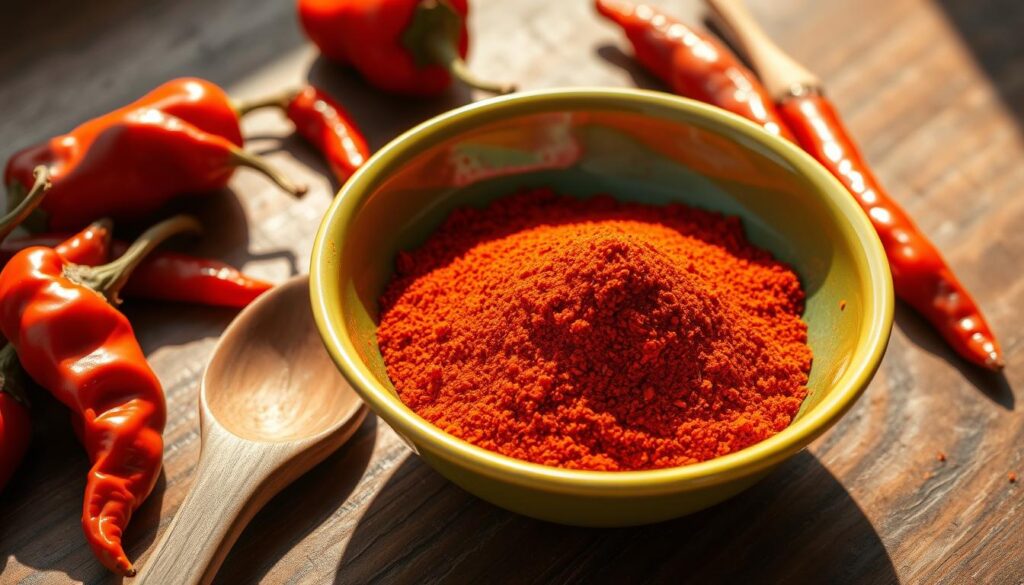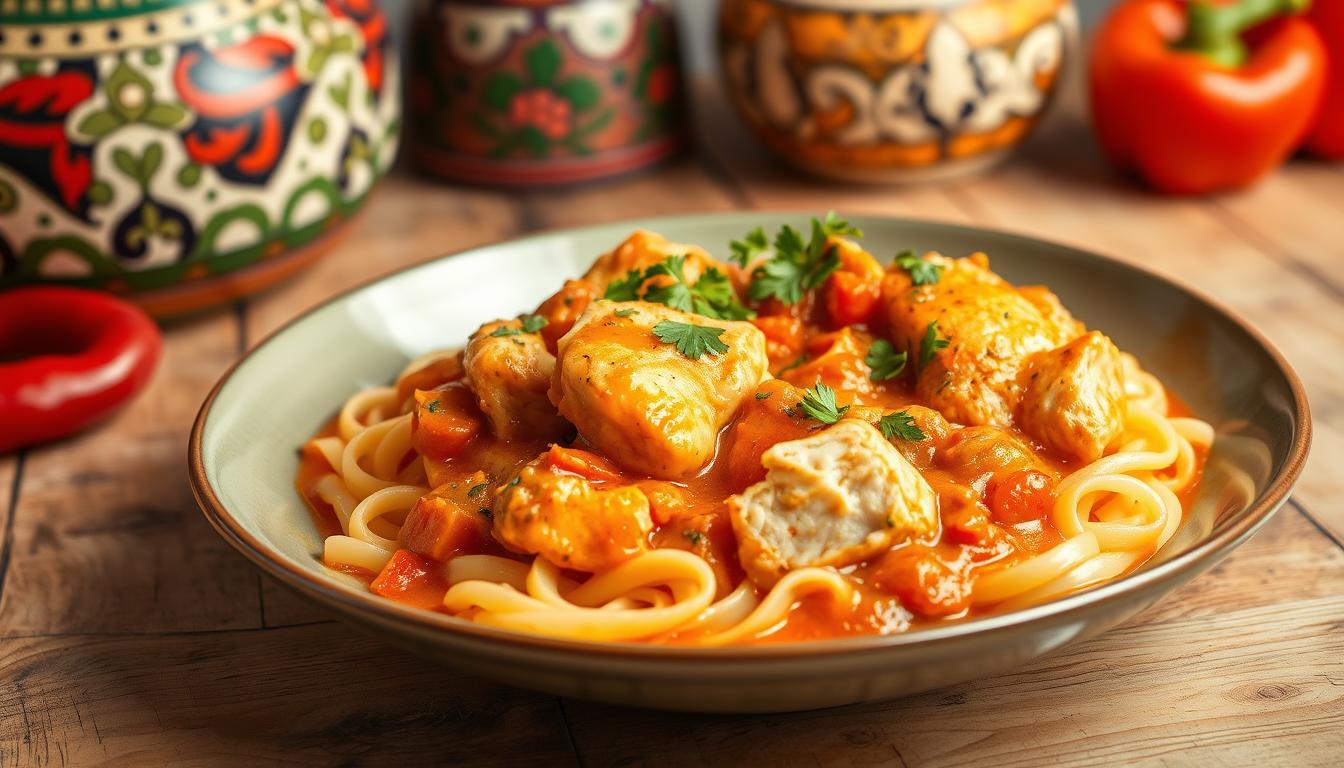Hungarian Chicken Paprikash is a beloved comfort dish. It features tender chicken in a creamy paprika sauce. This recipe has been passed down for generations, rooted in Hungarian tradition.
The dish uses boneless, skinless chicken thighs. It also includes onions, garlic, and bell peppers, all seasoned with rich Hungarian paprika. Served over nokedli (Hungarian dumplings) or egg noodles, it’s a satisfying meal that captures the essence of Central European cuisine.
Key Takeaways
- Hungarian Chicken Paprikash is a traditional comfort dish with a rich history.
- The dish features tender chicken, aromatic vegetables, and a creamy paprika-based sauce.
- Authentic recipes use boneless, skinless chicken thighs and high-quality Hungarian paprika.
- Serving the dish over nokedli (Hungarian dumplings) or egg noodles is a classic accompaniment.
- The dish is a satisfying and flavorful representation of Hungarian cuisine.
The Rich History of Hungarian Paprikash
Hungarian cuisine is known for its bold flavors and deep traditions. The Hungarian Paprikash is a prime example. It has roots in Hungarian cuisine, evolving from simple food to a national favorite over generations.
Origins in Hungarian Culinary Tradition
The story of Hungarian Paprikash starts with paprika. This spice, made from crushed peppers, is key in Hungarian cooking. It’s grown all over central Europe and is Hungary’s national spice.
Evolution Through Generations
As Hungarian Paprikash grew in popularity, families in Hungary and the Austro-Hungarian Empire made their own versions. They passed down these recipes for years. The dish became famous, loved in Central European dishes and a Budapest specialty.
Today, Hungarian Paprikash is a treasured tradition. It shows the country’s rich food history and paprika‘s role in Hungarian cuisine. From humble beginnings to a national dish, it has made a lasting impact on central European dishes and Budapest‘s food scene.
Essential Ingredients for Traditional Paprikash
Authentic Hungarian Chicken Paprikash is a dish that highlights the bold flavors of paprika seasoning, chicken stew, and creamy paprika sauce. It’s made with a few key ingredients that come together to create its signature taste.
Bone-in, skin-on chicken thighs and legs are the preferred cuts for this dish. The dark meat and crispy skin add layers of flavor and texture. High-quality Hungarian paprika, both sweet and smoky, is also essential. This spice gives the dish its deep red color and robust, slightly pungent taste.
Onions, garlic, and bell peppers add aromatic depth and sweetness, balancing the bold paprika. Tomatoes, whether fresh or canned, add acidity and body to the sauce. Chicken stock and full-fat sour cream complete the list, with the sour cream tempering the heat and adding a velvety texture.

With these key ingredients, the foundation for an authentic Hungarian Chicken Paprikash is set. The mix of flavors and textures makes for a satisfying and comforting meal that honors Hungary’s rich culinary traditions.
Understanding Hungarian Paprika Types
Hungarian paprika is the heart of authentic Hungarian Chicken Paprikash. It comes in several types, each adding a unique flavor to the dish.
Sweet Hungarian Paprika
The sweet Hungarian paprika is the most common in Hungarian cooking. It has a rich, slightly sweet taste that’s key to the dish’s flavor. Its mild heat and bright red color are crucial for the traditional Chicken Paprikash taste.
Smoked and Hot Paprika Varieties
Smoked and hot paprika are also used in Hungarian cooking. it adds a subtle, earthy flavor. Hot paprika brings a spicy kick that you can adjust to your liking. Together, these paprikas create the complex flavor of authentic Hungarian Chicken Paprikash.
Impact on Flavor Profile
The type and mix of paprika greatly affect Chicken Paprikash’s taste. Finding the right balance of sweet, smoky, and spicy is key to traditional Hungarian taste. Using these paprikas well is what makes Chicken Paprikash stand out from other chicken dishes.
| Paprika Variety | Flavor Profile | Typical Usage |
|---|---|---|
| Sweet Hungarian Paprika | Rich, slightly sweet taste | Foundation of Chicken Paprikash |
| Smoked Paprika | Earthy, subtle smokiness | Adds depth and complexity |
| Hot Paprika | Spicy, with varying heat levels | Adjusts the level of heat |
“The secret to authentic Hungarian Chicken Paprikash lies in the careful selection and balance of different paprika varieties.”
Choosing the Right Chicken Cuts
When making a chicken stew like the famous Hungarian traditional recipes, picking the right chicken cuts is key. Classic recipes often use bone-in, skin-on chicken parts. But, many now prefer boneless, skinless chicken thighs for their tenderness.
Chicken thighs are great for chicken stew because they have more fat. This fat keeps the meat juicy and tender, even when cooked for a long time. Some recipes mix thighs and legs, or even cut a whole chicken into parts. This mix helps get the best flavors and textures.
| Chicken Cut | Cooking Time | Flavor & Texture |
|---|---|---|
| Boneless, Skinless Chicken Thighs | Approximately 30 minutes | Rich, tender, and moist |
| Bone-in, Skin-on Chicken Legs or Thighs | Approximately 45 minutes | Robust, flavorful, and fall-off-the-bone tender |
| Whole Chicken, Cut into Parts | Approximately 60 minutes | Complex blend of white and dark meat, deeply savory |
Whatever chicken cuts you pick, season them well with salt and pepper before browning. This step creates a delicious caramelized crust. This crust adds a lot to the flavor of your chicken stew.
“The choice of chicken cuts can significantly impact the richness and texture of your traditional Hungarian chicken stew. Experiment to find the perfect balance that suits your personal preferences.”
The Art of Making Hungarian Chicken Paprikash
Learning to make authentic Hungarian Chicken Paprikash is a journey. It’s all about mastering the techniques for browning the chicken and making the creamy paprika sauce.
Proper Browning Techniques
Start by browning the chicken pieces well. This gives them a rich, caramelized flavor. Coat the chicken in flour, salt, and pepper before searing it in a hot pan with butter or oil.
This step is key. It locks in the juices and sets the dish’s flavor.
Creating the Perfect Sauce
To make the perfect sauce, sauté onions and garlic until they smell great. Then, add a lot of Hungarian paprika. This lets its smoky, earthy flavors come out.
Next, pour in chicken broth and let it simmer. This lets the flavors mix and thicken into a creamy sauce.
Tempering Sour Cream
The last step is adding sour cream. To avoid curdling, temper it first. Slowly add hot sauce to the sour cream while stirring constantly.
Then, gently mix it into the dish. This makes the sauce smooth and creamy, sticking well to the chicken.
With these techniques, you can make the creamy paprika sauce and traditional recipes just like Hungarian cooks have for generations. Enjoy the rich flavors and warm comfort of this classic dish.
Traditional Cooking Methods and Tips
Preparing the beloved Hungarian cuisine staple, comfort food like Chicken Paprikash, requires traditional methods. A whole chicken, cut into pieces, is best. It should weigh about 3-1/2 to 4 pounds each.
Slow braising is the preferred technique. It tenderizes the chicken and blends flavors together. Start by searing the chicken pieces in a heavy-bottomed pot or deep skillet. This step is crucial for developing the dish’s complex flavor profile.
- Cook the onions until they begin to soften, which takes approximately 6-8 minutes.
- Add the garlic and cook for an additional minute to release its aroma.
- Simmer the chicken until it reaches an internal temperature of 170°F, which generally takes around 30 minutes.
Keep the pot covered most of the time to retain moisture. Then, uncover it towards the end to let the sauce thicken. Basting the chicken with the sauce during cooking infuses it with rich, paprika-infused flavors.
“The secret to an authentic Hungarian Chicken Paprikash lies in the slow, careful preparation of the dish.”
By following these traditional cooking methods and tips, you’ll create a truly exceptional and comforting Hungarian cuisine experience in your own kitchen.
Classic Side Dishes and Accompaniments
When making the traditional Hungarian Chicken Paprikash, side dishes and accompaniments are key. They add to the dining experience. From Nokedli (Hungarian dumplings) to other options, they balance the paprikash’s rich flavors.
Nokedli (Hungarian Dumplings)
Nokedli, small, fluffy dumplings from eggs and flour, are perfect with Chicken Paprikash. They soak up the sauce well, offering a nice contrast to the chicken.
Alternative Serving Options
While Nokedli are traditional, other great options exist. Egg noodles and spaetzle, a central European noodle, pair well. For something heartier, creamy mashed potatoes or jasmine rice are good choices.
To cut the richness, try a tangy cucumber salad or pickled vegetables. Or, enjoy it with crusty bread to soak up the sauce.
Chicken Paprikash’s versatility means many side dish options. Whether it’s Nokedli, egg noodles, or something else, sides are crucial for a true Hungarian meal.
Common Mistakes to Avoid
Making the perfect traditional recipes like Hungarian Chicken Paprikash is a fun journey. But, it’s key to avoid a few common mistakes. This way, your creamy paprika sauce will be rich, flavorful, and true to Hungarian cooking.
One big mistake is burning the paprika. This makes the sauce bitter and unpleasant. To avoid this, add the paprika off the heat or at very low temperatures. This lets it infuse the sauce gently without burning.
Another mistake is adding cold sour cream to hot sauce. This can make the cream curdle. To fix this, slowly mix a bit of the hot liquid into the sour cream before adding it to the pan.
- Overcooking the chicken makes it dry and tough. Keep an eye on the cooking time and remove the chicken when it’s tender.
- Not browning the chicken enough can make it pale and flavorless. Spend time searing the chicken until it’s golden brown.
- Using low-quality or too little paprika can make the flavor weak. Use high-quality, freshly ground Hungarian paprika for the best taste.
By avoiding these mistakes and following traditional Hungarian cooking methods, you’ll make an amazing Chicken Paprikash. It will delight your senses and satisfy your taste buds.
| Preparation Time | Cook Time | Total Time | Servings |
|---|---|---|---|
| 20 minutes | 40 minutes | 1 hour | 6 |
Nutritional Information (Per Serving):
- Calories: 355
- Saturated Fat: N/A
- Trans Fat: N/A
- Polyunsaturated Fat: N/A
- Monounsaturated Fat: N/A
- Cholesterol: N/A
- Sodium: N/A
- Potassium: N/A
- Carbohydrates: N/A
- Protein: N/A
- Vitamin A: 1575 IU
- Vitamin C: N/A
- Calcium: N/A
“Perfecting traditional Hungarian recipes like Chicken Paprikash is a true labor of love, but avoiding common mistakes can make all the difference in the world.”
Storage and Reheating Guidelines
Enjoying Hungarian Chicken Paprikash doesn’t have to stop when it’s finished. You can enjoy the leftovers for days with the right storage and reheating. Let’s explore how to keep your chicken stew tasting great.
Proper Storage Methods
Keep your Hungarian Chicken Paprikash fresh by storing leftovers in an airtight container in the fridge. It stays fresh for up to 3 days. For longer storage, freeze it for up to 3 months. Freezing in individual portions makes reheating simpler.
Reheating Without Sauce Separation
When reheating your comfort food, do it gently to avoid sauce separation. The best way is to reheat it on the stovetop over low heat, stirring now and then. Don’t use a microwave, as it can break the sauce.
If the sauce is too thick, add a bit of chicken stock or water to thin it out. This will get the sauce back to the right consistency.
By following these easy storage and reheating tips, you can enjoy Hungarian Chicken Paprikash for a long time. Enjoy your comfort food whenever you want, thanks to these helpful suggestions.
Recipe Variations and Modern Adaptations
Traditional Hungarian Chicken Paprikash recipes are still loved, but new versions are also popular. Some add carrots or mushrooms for extra taste and health benefits. Others choose Greek yogurt for a lighter version instead of sour cream.
For those who don’t eat meat, there are vegetarian versions. These use mushrooms or tofu instead of chicken. Yet, the dish’s core – the creamy, paprika sauce – stays the same. This makes Hungarian Chicken Paprikash a classic that appeals to both fans of traditional recipes and modern foodies.
Embracing Versatility
Hungarian cuisine is known for its rich flavors and traditions. Chicken Paprikash is a prime example. Chefs and home cooks have creatively updated this dish:
- Adding seasonal veggies like bell peppers, zucchini, or spinach for color and texture
- Trying different proteins like pork, lamb, or tofu for a twist
- Using Greek yogurt or a mix of dairy for a lighter taste
- Serving it over rice, quinoa, or cauliflower “noodles” for a healthier option
Despite all the changes, the heart of Hungarian Chicken Paprikash stays the same. It’s a mix of tender chicken, aromatic spices, and a smooth sauce. This combination continues to excite and inspire cooks.
“The true beauty of traditional recipes lies in their ability to evolve and adapt to modern tastes, while still honoring the authentic flavors and techniques that have been passed down through generations.”
Wine Pairing and Serving Suggestions
When it comes to Hungarian cuisine, Chicken Paprikash is a standout. It pairs well with many wines. The dish’s bold flavors and the sauce’s richness make it a great match for several wines.
Red wine lovers will enjoy a light-bodied Kékfrankos (also known as Blaufränkisch) or a delicate Pinot Noir. These wines have the right acidity and tannins. They enhance the paprikash without overwhelming it.
For white wine fans, a crisp Furmint from Tokaj is perfect. Furmint’s high acidity cuts through the sauce’s creaminess. A light Chardonnay with minimal oak is also a good choice. It lets the dish’s flavors stand out.
| Wine Variety | Region | Tasting Notes | Pairing Recommendation |
|---|---|---|---|
| Kékfrankos | Hungary | Light-bodied, balanced acidity and tannins | Excellent choice for Chicken Paprikash |
| Pinot Noir | Various | Delicate, with red fruit and earthy notes | Complements the richness of the dish |
| Furmint | Tokaj, Hungary | High acidity, can range from dry to sweet | Cuts through the creaminess of the paprikash |
| Chardonnay | Various | Crisp, with minimal oak influence | Allows the flavors of the dish to shine |
When serving Chicken Paprikash, serve it family-style. Use a large bowl or individual plates. Place the chicken in the sauce over dumplings or noodles. Add fresh parsley for color.
“Hungarian cuisine is a treasure trove of rich, flavorful dishes that are deeply rooted in the country’s culinary tradition. Chicken Paprikash, with its layers of spices and creamy sauce, is a true comfort food classic that pairs beautifully with a carefully selected wine.”
Conclusion
Hungarian Chicken Paprikash is a true gem from Hungary’s rich food history. It’s a dish that wraps tender chicken in a smooth paprika-based sauce. This comfort food has won the hearts of many, no matter the recipe used.
The mix of sweet and smoky paprika, tangy sour cream, and soft dumplings makes it special. Its roots in the 19th century, when paprika became key in Hungarian cooking, have made it even more beloved.
Enjoying Hungarian Chicken Paprikash is like taking a trip to Hungary. It brings the country’s rich flavors and traditions to your table, loved by food lovers everywhere.


